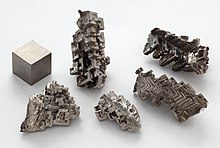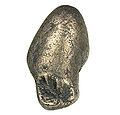Bismuth
 | ||||||||||||||||||||||||||||||||||||||||
| Bismuth | ||||||||||||||||||||||||||||||||||||||||
|---|---|---|---|---|---|---|---|---|---|---|---|---|---|---|---|---|---|---|---|---|---|---|---|---|---|---|---|---|---|---|---|---|---|---|---|---|---|---|---|---|
| Pronunciation | /ˈbɪzməθ/ | |||||||||||||||||||||||||||||||||||||||
| Appearance | lustrous brownish silver | |||||||||||||||||||||||||||||||||||||||
| Standard atomic weight Ar°(Bi) | ||||||||||||||||||||||||||||||||||||||||
| 208.98040(1)[1] | ||||||||||||||||||||||||||||||||||||||||
| Bismuth in the periodic table | ||||||||||||||||||||||||||||||||||||||||
| ||||||||||||||||||||||||||||||||||||||||
| Group | group 15 (pnictogens) | |||||||||||||||||||||||||||||||||||||||
| Period | period 6 | |||||||||||||||||||||||||||||||||||||||
| Block | p-block | |||||||||||||||||||||||||||||||||||||||
| Electron configuration | [Xe] 4f14 5d10 6s2 6p3 | |||||||||||||||||||||||||||||||||||||||
| Electrons per shell | 2, 8, 18, 32, 18, 5 | |||||||||||||||||||||||||||||||||||||||
| Physical properties | ||||||||||||||||||||||||||||||||||||||||
| Phase at STP | solid | |||||||||||||||||||||||||||||||||||||||
| Melting point | 544.7 K (271.5 °C, 520.7 °F) | |||||||||||||||||||||||||||||||||||||||
| Boiling point | 1837 K (1564 °C, 2847 °F) | |||||||||||||||||||||||||||||||||||||||
| Density (near r.t.) | 9.78 g/cm3 | |||||||||||||||||||||||||||||||||||||||
| when liquid (at m.p.) | 10.05 g/cm3 | |||||||||||||||||||||||||||||||||||||||
| Heat of fusion | 11.30 kJ/mol | |||||||||||||||||||||||||||||||||||||||
| Heat of vaporization | 179 kJ/mol | |||||||||||||||||||||||||||||||||||||||
| Molar heat capacity | 25.52 J/(mol·K) | |||||||||||||||||||||||||||||||||||||||
Vapor pressure
| ||||||||||||||||||||||||||||||||||||||||
| Atomic properties | ||||||||||||||||||||||||||||||||||||||||
| Oxidation states | −3, −2, −1, 0,[2] +1, +2, +3, +4, +5 (a mildly acidic oxide) | |||||||||||||||||||||||||||||||||||||||
| Electronegativity | Pauling scale: 2.02 | |||||||||||||||||||||||||||||||||||||||
| Ionization energies |
| |||||||||||||||||||||||||||||||||||||||
| Atomic radius | empirical: 156 pm | |||||||||||||||||||||||||||||||||||||||
| Covalent radius | 148±4 pm | |||||||||||||||||||||||||||||||||||||||
| Van der Waals radius | 207 pm | |||||||||||||||||||||||||||||||||||||||
| Other properties | ||||||||||||||||||||||||||||||||||||||||
| Natural occurrence | primordial | |||||||||||||||||||||||||||||||||||||||
| Crystal structure | rhombohedral[3] | |||||||||||||||||||||||||||||||||||||||
| Speed of sound thin rod | 1790 m/s (at 20 °C) | |||||||||||||||||||||||||||||||||||||||
| Thermal expansion | 13.4 µm/(m⋅K) (at 25 °C) | |||||||||||||||||||||||||||||||||||||||
| Thermal conductivity | 7.97 W/(m⋅K) | |||||||||||||||||||||||||||||||||||||||
| Electrical resistivity | 1.29 µΩ⋅m (at 20 °C) | |||||||||||||||||||||||||||||||||||||||
| Magnetic ordering | diamagnetic | |||||||||||||||||||||||||||||||||||||||
| Molar magnetic susceptibility | −280.1·10−6 cm3/mol[4] | |||||||||||||||||||||||||||||||||||||||
| Young's modulus | 32 GPa | |||||||||||||||||||||||||||||||||||||||
| Shear modulus | 12 GPa | |||||||||||||||||||||||||||||||||||||||
| Bulk modulus | 31 GPa | |||||||||||||||||||||||||||||||||||||||
| Poisson ratio | 0.33 | |||||||||||||||||||||||||||||||||||||||
| Mohs hardness | 2.25 | |||||||||||||||||||||||||||||||||||||||
| Brinell hardness | 70–95 MPa | |||||||||||||||||||||||||||||||||||||||
| CAS Number | 7440-69-9 | |||||||||||||||||||||||||||||||||||||||
| History | ||||||||||||||||||||||||||||||||||||||||
| Discovery | Arabic alchemists (before AD 1000) | |||||||||||||||||||||||||||||||||||||||
| Isotopes of bismuth | ||||||||||||||||||||||||||||||||||||||||
| ||||||||||||||||||||||||||||||||||||||||

Bismuth is a chemical element. It is element 83 on the periodic table and its symbol is Bi. Its atomic mass is 209. It is only slightly radioactive. The radioactivity is minimal so it is typically seen as nonradioactive. Bismuth is only naturally found as one isotope, which is the almost nonradioactive one. Its radioactivity was predicted by scientists and proven by analyzing the metal. It is in Group 15 on the periodic table.
Properties[change | change source]
Physical properties[change | change source]

Bismuth is a silver metal with a pink tinge to it. This pink color is because of its oxide coating. Bismuth is a post-transition metal. It is one of the strongest diamagnetic metals. It is almost as heavy as lead. It is quite brittle. It can make crystals with a shiny surface. Its melting point is quite low: 271.5 °C (520.7 °F), which is normal for post-transition metals. As a liquid it is denser and has a smaller volume than as a solid. Another chemical that does this is water. It does not conduct electricity or heat very well.
Chemical properties[change | change source]
Bismuth is somewhat similar to antimony. Bismuth makes a thin coating of bismuth(III) oxide when it is in air. This makes the colors on the crystals. It does not oxidize any more than the oxide layer. It burns when powdered with a bright blue flame, making yellow bismuth(III) oxide fumes. Bismuth also reacts with sulfur, when molten. Bismuth reacts with nitric acid to make bismuth(III) nitrate and concentrated sulfuric acid to make bismuth(III) sulfate and sulfur dioxide. It reacts with halogens to make bismuth(III) halides but with fluorine it makes bismuth(V) fluoride unless the fluorine is diluted.
Chemical compounds[change | change source]
Bismuth forms chemical compounds in two main oxidation states: +3 and +5. +3 is more common. +3 compounds are weak oxidizing agents and are normally light yellow. +5 compounds are strong oxidizing agents. Bismuthates are the most common +5 compounds. Bismuth(V) fluoride is another +5 compound. Bismuth(V) oxide is an unstable red solid. Bismuth sulfide is a common ore of bismuth. Bismuthine, a bismuth hydride, is very unstable and only can be made at very cold temperatures. Bismuth makes many oxy- compounds like bismuth oxychloride. These compounds are made when bismuth halides dissolve in water.
Trioxides[change | change source]
+3 compounds are weak oxidizing agents except for bismuthine. They are normally pale yellow.
- Bismuthine, unstable gas
- Bismuth(III) bromide, pale yellow solid
- Bismuth(III) chloride, pale yellow solid
- Bismuth(III) fluoride, gray white solid
- Bismuth(III) iodide, dark gray solid
- Bismuth(III) oxide, pale yellow solid
- Bismuth(III) oxychloride, whitish solid
- Bismuth(III) sulfide, brown solid
Pentoxides[change | change source]
Bismuth(V) oxides (+5 compounds) are very strong oxidizing agents. Its chemical formula is Bi2O5. It is a scarlet red solid. It decomposes to bismuth(III) oxide and oxygen easily. It is made by electrolysis of bismuth(III) oxide in a hot concentrated alkali like sodium hydroxide.
- Bismuth(V) fluoride, colorless solid
- Bismuth(V) oxide, unstable red solid
- Bismuthate, the ion
- Sodium bismuthate, light brown solid, insoluble in water
-
Bismuth(III) oxide
-
Bismuth(III) sulfide
-
Bismuth(III) nitrate
-
Bismuth(III) chloride
-
Sodium bismuthate
History[change | change source]
Bismuth was known since ancient times. It was confused with tin and lead, though. No one is credited for discovering bismuth. In the 1500s, people started realizing that bismuth was different than tin or lead.
Occurrence[change | change source]
-
Bismite
-
Bismuth as a mineral
-
Bismuthinite
Bismuth is not very common in the earth. It is only about twice as common as gold. Bismite, a bismuth oxide mineral, and bismuthinite, a bismuth sulfide, are two common ores. Bismuth is sometimes found as a metal, too.
Preparation[change | change source]
Bismuth and its minerals are too rare to be mined. They are gotten by "secondary extraction". It is normally found in lead metal. The lead metal is purified by electrolysis, leaving the bismuth behind as a sludge on the bottom of the container. The copper is taken out of the sludge and the bismuth is purified by being reduced in a furnace and all the impurities are filtered out.
China makes the most bismuth. Peru, Mexico, and Japan also make bismuth.
Bismuth can also be recycled. This is difficult in many places because bismuth is used for things like bullets, solder, and stomach medicine that get scattered all over and cannot easily be gotten again.
Uses[change | change source]
As an element[change | change source]
Bismuth is used in alloys with very low melting points. Some of them melt in hot water. They are also found in solder that does not have lead in it. It can make alloys with other metals to make them more malleable. It is also used in bullets to replace lead. In some places lead bullets are outlawed as birds eat them and get lead poisoning. It is also used in alloys for plumbing. It is used in fishing sinkers.
As chemical compounds[change | change source]
Bismuth is used in some medicines such as Pepto-Bismol. This medicine has bismuth subsalicylate in it. It is also used as an internal deodorant and to treat eye infections and peptic ulcers.
Bismuth oxychloride is used in cosmetics. Bismuth telluride is used in electronic thermometers. Another compound is used in superconductors and becomes a superconductor at a high temperature. It can be used as a pigment and in fireworks to make crackling sounds. It is used in the nuclear fuel of a nuclear reactor.
Safety[change | change source]
Bismuth is much less toxic than other heavy metals. This is why it is replacing lead in many things. It does not add up in the body like other heavy metals do. A very large amount of bismuth can poison the kidneys and liver, though. Because its oxide does not dissolve in water, it is considered safe for the environment. Bismuth's radioactivity is so weak that it's not considered a hazard.
| H | He | ||||||||||||||||||||||||||||||||||||||||
| Li | Be | B | C | N | O | F | Ne | ||||||||||||||||||||||||||||||||||
| Na | Mg | Al | Si | P | S | Cl | Ar | ||||||||||||||||||||||||||||||||||
| K | Ca | Sc | Ti | V | Cr | Mn | Fe | Co | Ni | Cu | Zn | Ga | Ge | As | Se | Br | Kr | ||||||||||||||||||||||||
| Rb | Sr | Y | Zr | Nb | Mo | Tc | Ru | Rh | Pd | Ag | Cd | In | Sn | Sb | Te | I | Xe | ||||||||||||||||||||||||
| Cs | Ba | La | Ce | Pr | Nd | Pm | Sm | Eu | Gd | Tb | Dy | Ho | Er | Tm | Yb | Lu | Hf | Ta | W | Re | Os | Ir | Pt | Au | Hg | Tl | Pb | Bi | Po | At | Rn | ||||||||||
| Fr | Ra | Ac | Th | Pa | U | Np | Pu | Am | Cm | Bk | Cf | Es | Fm | Md | No | Lr | Rf | Db | Sg | Bh | Hs | Mt | Ds | Rg | Cn | Nh | Fl | Mc | Lv | Ts | Og | ||||||||||
| |||||||||||||||||||||||||||||||||||||||||
- ↑ "Standard Atomic Weights: Bismuth". CIAAW. 2005.
- ↑ Bi(0) state exists in a N-heterocyclic carbene complex of dibismuthene; see Deka, Rajesh; Orthaber, Andreas (May 6, 2022). "Carbene chemistry of arsenic, antimony, and bismuth: origin, evolution and future prospects". Royal Society of Chemistry. 51 (22): 8540–8556. doi:10.1039/d2dt00755j. PMID 35578901. S2CID 248675805.
- ↑ Cucka, P.; Barrett, C. S. (1962). "The crystal structure of Bi and of solid solutions of Pb, Sn, Sb and Te in Bi". Acta Crystallographica. 15 (9): 865. doi:10.1107/S0365110X62002297.
- ↑ Weast, Robert (1984). CRC, Handbook of Chemistry and Physics. Boca Raton, Florida: Chemical Rubber Company Publishing. pp. E110. ISBN 0-8493-0464-4.
- ↑ Kondev, F. G.; Wang, M.; Huang, W. J.; Naimi, S.; Audi, G. (2021). "The NUBASE2020 evaluation of nuclear properties" (PDF). Chinese Physics C. 45 (3): 030001. doi:10.1088/1674-1137/abddae.








